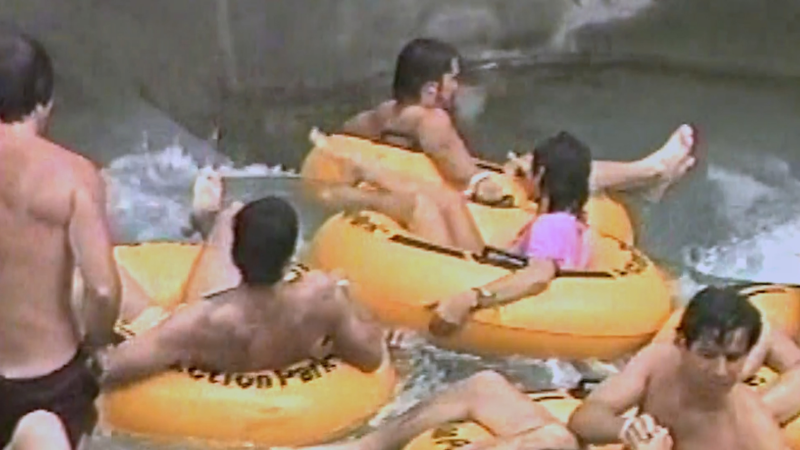Review: Class Action Park
Death in the afternoon

Mockers of my native state of New Jersey are usually careful to acknowledge what they see as the few positive aspects of the place. It's the home of Springsteen and Sinatra, of course, and an excellent source of big-ass tomatoes and ambrosial Taylor Pork Roll, the king of processed breakfast meats.
But naysayers always bring up the lamentable stuff, too. Not just Joe Piscopo or the ridiculous Jersey Devil, but also the Garden State's vast number of toxic-waste dumps and homegrown goombahs like Richard "Iceman" Kuklinski, a mob assassin who claimed to have terminated 200 people and who surely served as some kind of role model for his little brother, the rapist and murderer Joseph Kuklinski.
Not easily situated in either the pro or the con category would be Action Park, an outdoor amusement attraction in northern New Jersey that from 1978 to 1996 was probably the world's most dangerous fun venue. On one hand, the park offered the liberation of extreme, largely unchaperoned thrills to a generation of bored latchkey kids in the New York tri-state area. On the other hand, some of them left the place in body bags.
The Action Park story is related in transfixing detail in a new HBO Max documentary called Class Action Park. ("Fracture Park" was another of the site's inevitable bynames.) Directors Seth Porges and Chris Charles Scott III have done a brisk job of interweaving sunny, soft-focus archive footage of the old park with contemporary testimony from the park's surviving employees and patrons. ("Every member of my family was injured at that park," says Jimmy Kimmel.)
Action Park was the creation of a Wall Street wild man named Gene Mulvihill, who found himself at loose ends after his stock operation was shut down by the SEC in the mid-1970s. He bought and combined two ski resorts near leafy Vernon Township, then realized he'd have to find some way to make it pay off in the warm-weather months, too. Thus impelled, Mulvihill created what may have been the world's first water park. Unfortunately, says Jersey-boy comic Chris Gethard, "they didn't consult anybody who had a background in engineering."
Indeed, one of the park's more terrifying rides—the Cannonball Loop—started out as a doodle on a napkin, which Mulvihill turned over to some welders to actualize. It was a huge closed tube, pitch dark inside, through which kids found themselves rocketing at uncontrollable velocities. "There's two places you can experience 9G as a civilian," says a veteran employee. "One is the back seat of an F-14. The other one [was] at Action Park."
Mulvihill's water park was an instant hit. Looking back to her youth, one woman says, "there were no rules, and for a lot of kids, that was heaven." Indeed, many of the park's ride attendants were underage (some as young as 14) and kids as young as six could be found perched atop an artificial bluff preparing to make a 20-foot leap into the crowded water below. In addition, among the park's many proffered entertainments was a German beer brewery—where a kid would have to try pretty hard not to get served, apparently—and it was situated right next door to Motor World, which offered mini race cars and powerboats to tear around in. (There was also a major state highway running through the property, just to keep things interesting.)
The park's most dangerous ride might have been the Alpine Slide—a ski-lift affair in which the schuss back down was over raw concrete. In the doc we're told that the slide chewed up kids at a fearsome rate, leaving them with dislocated shoulders, broken arms and, in one girl's case, a severed finger. Mulvihill took considerable pains not to report every injury—he was a man who felt that if you took your chances, you had to be ready to swallow the pain. Nevertheless, the stats that he did own up to were disturbing: At the end of the 20-week summer season of 1986, a local paper, the Sunday Herald, reported that there had been more than 330 people injured at Action Park.
This was an especially vexing problem because Mulvihill couldn't get anyone to provide insurance for the chaotically managed park. To finesse that, he invented his own fake insurance company and incorporated it in the Cayman Islands. When the occasional Action Park customer did sue, he would never settle, but instead would keep the plaintiffs marooned in court, watching their money dribble away.
Action Park's time was running out, however. One kid was electrocuted on a "Kayak Experience" ride, another drowned in the Wave Pool, and Mulvihill was forced to start closing down rides. "People thought that drowning in the Action Park Wave Pool was part of the experience," says a former attendant. (We're told that the Pool was actually a soup of dirt runoff, suntan lotion, body wastes, and blood from open wounds.)
At the end of the film, its farcical tone turns darker as we meet a woman whose son was killed at Action Park, and who got no sympathy from Mulvihill, and who is still heartbroken and angry today. It's impossible to laugh through her tears. Still, for many other survivors, memories have softened over the years.
"I think the very reason people were attracted to Action Park was because they could get hurt," says one man. "That was the allure of it. I mean, who wants to sit on a Ferris wheel?"


Show Comments (31)